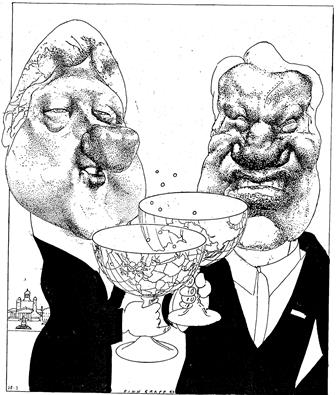Drawing with Metaphors. Mediating ideational content in drawing through metaphors
DOI:
https://doi.org/10.7577/formakademisk.744Keywords:
, ideational drawing, cognitive linguistic metaphor theory, metaphor, metonymy, educational devicesAbstract
It is not easy to express abstract concepts, such as time and society, in a drawing. The subject of this article is rooted in the educational issue of visually expressing themes represented by abstract concepts. However, it is possible to find means and devices to express such ideas. This article shows how metaphors can be used to express such ideas visually. Cognitive linguistic research argues that metaphors are crucial in the verbal communication of abstract concepts. This article also attempts to show that metaphors are important in visual communication. The cognitive linguistic metaphor theory of George Lakoff and Mark Johnson is used here to investigate how metaphors are used to construct meaning in the drawings of cartoonist and illustrator Finn Graff and artist Saul Steinberg. The article presents a few examples of how visual devices structure the abstract concept of time. It then proceeds to explain how symbols function as metonymies and provides an overview of the different types of metaphors and how they are used to express meaning in drawings. The article concludes by attempting to provide new insights regarding the use of visual metaphors.

Downloads
Published
How to Cite
Issue
Section
License
Authors who publish with this journal agree to the following terms:
- Authors retain copyright and grant the journal right of first publication with the work simultaneously licensed under a Creative Commons Attribution 4.0 License that allows others to share the work with an acknowledgement of the work's authorship and initial publication in this journal.
- Authors are able to enter into separate, additional contractual arrangements for the non-exclusive distribution of the journal's published version of the work (e.g., post it to an institutional repository or publish it in a book), with an acknowledgement of its initial publication in this journal.
- Authors are permitted and encouraged to post their work online (e.g., in institutional repositories or on their website) prior to and during the submission process, as it can lead to productive exchanges, as well as earlier and greater citation of published work (See The Effect of Open Access).
- The author(s) must manage their economic reproduction rights to any third party.
- The journal makes no financial or other compensation for submissions, unless a separate agreement regarding this matter has been made with the author(s).
- The journal is obliged to archive the manuscript (including metadata) in its originally published digital form for at least a suitable amount of time in which the manuscript can be accessed via a long-term archive for digital material, such as in the Norwegian universities’ institutional archives within the framework of the NORA partnership.
The material will be published OpenAccess with a Creative Commons 4.0 License which allows anyone to read, share and adapt the content, even commercially under the licence terms:
This work needs to be appropriately attributed/credited, a link must be provided to the CC-BY 4.0 licence, and changes made need to be indicated in a reasonable manner, but not in any way that suggests that the licensor endorses you or your use.



